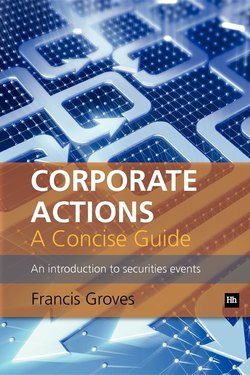Читать книгу Corporate Actions - A Concise Guide - Francis Groves - Страница 32
На сайте Литреса книга снята с продажи.
Endnotes
Оглавление10 For example, a rights issue is usually thought of as a single corporate action in terms of its import for the investor, but corporate action practitioners may see it as two separate actions; firstly, the distribution of the rights (nil-paid) and, secondly, the (call) payment for the new shares. [return to text]
11 ‘Lost in Transcription’ (The Banker, 1st June 2007). [return to text]
12 Infosys white paper (Ramamurthy, Arora & Ghosh, November 2005). [return to text]
13 These VOC dividend percentages are not true dividend yields based on the price the shares were trading at when the dividend was paid – in the early years of the 17th century there was no official quoted price with which to calculate a true dividend yield. Instead, the VOC dividend is expressed as a percentage of the price of the shares at issue (ie, their face value). [return to text]
14 Chapter 9 looks at the tax implications of different kinds of corporate action in more detail. [return to text]
15 Money Observer features its ‘ten per cent club’ annually. The UK companies listed have increased their dividends by 10% over 10 successive years. [return to text]
16 The ex-dividend date is the first day on which purchasing the shares would not entitle the investor to the dividend in question. The record date is the date on which the registrar would compile the list of shareholders due to be paid (these important dates are dealt with in more detail in the next chapter). Note that the approval of the final dividend payment would normally be the subject of a shareholder vote at the AGM, so the shareholders’ approval is retrospective. If a company operates a dividend re-investment scheme they will normally make clear to shareholders the latest date for joining or exiting the scheme. In the above example a shareholder would know that they had to opt into the dividend re-investment plan by, say, 23rd April to be sure of having their final dividend re-invested. [return to text]
17 This description of ‘scrip’ is true in UK parlance. In the United States, the term ‘scrip dividend’ seems to be ambiguous and is sometimes used to describe a promissory note in lieu of an actual cash dividend. The term ‘stock dividend’ meaning a dividend paid in shares is also current in the US. [return to text]
18 Barclays Capital Equity Gilt Study, 2005. [return to text]
19 Not to be confused with bonus share plans in Australia (which are covered in the glossary). [return to text]
20 ‘Corporate Actions Processing, What are the Risks?’ (Oxera, 2004). [return to text]
21However, there is an informal arrangement whereby the trade associations of the UK’s institutional investors allow small issues of shares to be made that don’t take account of shareholders’ pre-emptive rights. Appendix lll looks at the subject of pre-emptive rights and non-rights issues in more detail. [return to text]
22 This does not have to be an ‘all or nothing’ decision; shareholders are perfectly entitled to take up some of their rights but not all of them. [return to text]
23 See Appendix lll for more detail on pre-emption and alternatives for issuers. See also the phrase “excess application” in the Glossary of terms. [return to text]
24 Of course, there may be other arguments in favour of a takeover that don’t reflect badly on the current management, for example, economies of scale or the desire of the acquiring company to gain access to the distribution channels of the target company. The subject of the long-term outcomes for mergers has been much researched and the view that only a minority are truly successful seems on the way to becoming orthodox. [return to text]
25 Once a takeover has been successful a shareholder who did not accept the offer at the time has ‘sell out’ rights, the right to have their stake bought out by the new parent company. However, the acquirer will have “squeeze out” rights if their shareholding rises above a certain proportion (normally around 90% - EU law stipulates 90-95% but devolves the precise level to the decision of individual member states). [return to text]
26 See Chapter 3. [return to text]
27 See Chapter 7. [return to text]
28 Another form of de-merger would be a management buyout. [return to text]
